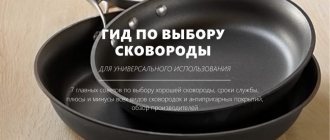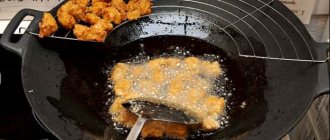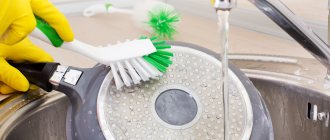I, being a conservative by nature, never chase newfangled trends. I also try to take care of my health and the health of my family. Like many of my friends, I do not use frying pans with a non-stick coating for cooking, as I doubt its safety, but I buy the most budget models.
Of course, we must admit that food often sticks or burns on them. But as they say, there are no hopeless situations. And I found some simple ways to make surfaces coated with a protective layer yourself.
Non-stick cookware
Today there are different coatings that prevent food from burning. These are Teflon, marble, ceramics and titanium. They make cooking quick and hassle-free.
When using cookware with a non-stick top layer, it is necessary to take into account the recommendations for caring for the product so that it lasts longer and does not harm the health of family members.
Teflon pans are easy to use. There is no need to oil them while cooking. But when heated, they can release harmful substances. Caring for a frying pan with a non-stick Teflon coating should be thorough:
- Avoid using iron devices. It is better to give preference to wooden, rubber or silicone.
- Wash dishes only with a soft sponge. Do not use metal brushes. They create microscopic cracks that destroy the coating of the pan.
- Do not hold hot dishes without food for a long time on the fire.
- Eliminate friction. It is better to soak the container for a while.
Ceramic products are considered environmentally friendly, but also have their own characteristics. It is not recommended to heat them. Too high temperatures are contraindicated for the ceramic layer. If such a surface has deteriorated and food begins to burn, it is impossible to correct the situation at home.
I used to buy non-stick frying pans, but now I make them myself: I’m sharing the method
I, being a conservative by nature, never chase newfangled trends. I also try to take care of my health and the health of my family. Like many of my friends, I do not use frying pans with a non-stick coating for cooking, as I doubt its safety, but I buy the most budget models.
Of course, we must admit that food often sticks or burns on them. But as they say, there are no hopeless situations. And I found some simple ways to make surfaces coated with a protective layer yourself.
What you need to do to prevent a non-stick frying pan from burning
To prevent any pan from burning, you must adhere to the following rules:
- Cook food only on clean and washed dishes. Layering of contaminants must be avoided.
- Avoid temperature changes. It is not recommended to lower a hot frying pan into cold water.
- Frozen food should not be placed on a heated surface. It’s better to take the time to defrost them and then start cooking.
- Gentle detergents and devices should be used.
If a frying pan burns, you need to pay attention to its material. Aluminum or cast iron can be revived without much expense. They have a porous surface that wears off over time.
First, the dishes need to be washed well. Baking soda will help with this. It is poured into a container with water and the pan is boiled in the solution for some time. Afterwards, the liquid is drained and its remains are disposed of.
After thoroughly rinsing off the soda solution, sprinkle coarse kitchen salt onto the bottom of the dish and place on the fire. You can use the oven. The frying pan is heated for 20-30 minutes, after which it is set aside to cool. When all the salt has been removed, the surface is greased with vegetable oil.
Another simple method is to fry the bread on the surface that has become unusable. The bread absorbs food residues and dirt that have formed during the operation of the product.
Enameled cookware should not be heated. It needs to be cleaned, dried with a towel, and generously rubbed with lard or other fat. For a high-quality result, the procedure is repeated before each use of the dishes.
LiveInternetLiveInternet
Drying oils, unlike all other vegetable oils and animal fats, form a hard film when dried, like varnish, like enamel. So in a frying pan you need to heat the same drying oil that you will also find in oil paints that painters use to paint their pictures, and after a while the paint dries forever on the canvas and it becomes hard and shiny. And, of course, painters use the same drying oil in paint when they paint walls, metal, and wood with oil paint, which dries into a shiny, durable coating that is smooth to the touch. There are several edible drying oils you can find in grocery stores: flaxseed, poppy seed, walnut, and tung nut (tung) oil. Any of them will create a beautiful smooth black coating on the surface of the cast iron, and if you apply more than 5 layers, it will also be shiny. And if the frying pan is smooth, and you apply 20 layers, then in the bottom of the frying pan you can look at yourself as if in a black mirror.
You can use ordinary drying oil from a building materials store, but only natural one, consisting of linseed oil with the addition of turpentine, and not drying oil-like products made from sunflower oil with white spirit, i.e. finding oil is not a problem.
After the cast iron has been heated to absolute dryness for an hour at a temperature of 200-250C, it is removed and greased with a drop of drying oil on the grate. If the cast iron is very smooth, then a drop will be enough for a whole frying pan.
Only if the handle has intricate parts and grooves, it will be possible to apply more oil there with the tip of a rag or a brush made of natural bristles (the frying pan is hot, you cannot use a synthetic brush).
It is extremely important to apply the oil in a thin layer so that the cast iron is almost dry and shiny. If you oil cast iron so that it looks “wet”, it will dry out in patches and then may “peel” In fact, several thin layers of oil are better than several thick ones! Therefore, we wipe the excess dry before calcining the freshly applied layer.
Then you need to put the oiled cast iron in a hot oven and calcinate it at the maximum temperature, which for household ovens is about 250C.
Why in the oven? You can, of course, calcinate it over an open fire, on an electric or gas burner, but in this case it is difficult to maintain the temperature regime - you can either burn the oil or underdry it, but in the oven this process is more convenient. There are adherents of natural drying in the sun, in the open air, where ventilation is intense and ultraviolet radiation contributes to polymerization. But this process is long, akin to art, and not everyone will be able to use it, so calcination in the oven is the easiest and most reliable way.
The duration of calcination depends on the oil used. For example, tung oil polymerizes in 30 minutes, but linseed oil needs to be calcined longer: 1 hour, then turn off the oven and leave to dry for two hours at a decreasing temperature.
To apply the next layer, heat again to maximum, lubricate, leave for an hour, cool for two hours, etc. During this time, the coating on the cast iron will brown and become completely dry to the touch. Or, on cast iron of a different quality, different age, porosity and composition, it will remain practically unchanged. But already the third and fourth layers of calcined oil will completely change the appearance and quality of the coating inside and outside of cast iron cookware. The fourth layer is a deep black chocolate color.
Now, in cast iron that has been well calcined with oil, you can cook anything for many years, including baking, boiling, frying, and grilling. The only thing that cooking and braising in cast iron will do, says Greg, author of a wonderful blog about cast iron utensils, baking and cooking in it, is that the protective layer may tarnish. But shine, of course, can be easily restored by calcination with several layers of oil, if shine is so strongly needed for aesthetics.
https://apxiv.ucoz.ru/blog/chugun/2012-07-01-49
Teflon substitute for making pancakes and omelettes
An excellent coating for cooking pancakes is Teflon. Food in such a frying pan does not burn and quickly lags behind the surface. If there is no Teflon layer or it needs to be replaced on the dishes, you can apply the coating yourself.
Cast iron frying pans are still found in homes. Their main drawback is weight. They are too heavy, so they are inconvenient when preparing pancakes and omelettes.
Aluminum containers with ceramic coating are lighter. They have a protective layer that prevents food from burning. For a frying pan to work for a long time, it needs proper and careful care. If damage occurs, then restoring the non-stick ceramic coating is impossible and you need to look for a new option.
Steel cookware with a non-stick coating is practical. It is durable and does not react chemically with food, so it does not affect the taste of the food. To prevent pancakes from sticking, the product must be clean and have a thick bottom.
Method two: using canola oil
As in the first case, a thoroughly washed frying pan must be dried over a fire. After that, pour canola oil into it, also known as rapeseed oil. It contains a minimal amount of additives, so its use will be the most optimal option for health. At the same time, it has good lubricating properties.
Once the oil is evenly distributed in the pan, let it sit overnight. On the second day, you can use the dishes for their intended purpose. Thus, an ordinary frying pan turns into a non-stick frying pan with simple manipulations and without any significant costs.
Making a Teflon coating for a frying pan with your own hands
If the Teflon frying pan begins to burn, this indicates damage to the protective layer or its poor quality. It is impossible to completely restore the original properties of the coating, but you can try to correct the situation at home. To do this, boil a mixture of water, laundry soap and a small amount of vinegar in a frying pan for 15 minutes.
After draining the solution, the dishes should be rinsed, gently rubbed with a soft sponge and dried. Grease the prepared surface with oil and start frying. If the procedure does not work, it is worth applying a Teflon coating, which will be done efficiently and quickly by specialists.
Option three: using coconut oil and salt
To bring it to life you will need:
Place the frying pan on the stove over medium heat. Then add one tablespoon of butter to it and heat it until it melts. Spread the coconut oil evenly throughout the pan and drain off the excess. After this, add a layer of salt to evenly cover the bottom of the vessel.
Take a paper towel and use it to rub the salt and oil into the surface, as if polishing it. After this, you need to take another, clean paper towel. You will need this to get rid of excess coconut oil and salt. When these manipulations are completed, your frying pan is ready for food to be cooked on it without burning.
In conclusion, these methods are not intended for long-term use as non-stick cookware. You should repeat the process when you feel the food starting to stick again.
And when cooking, you will still need to use vegetable or other oil to prevent sticking. However, these are just minor inconveniences in exchange for a clean and safe pan.
Source
Non-stick coating restoration workshops
Restoring Teflon coatings has recently become possible. Workshops are opening that specialize in high-quality replacement of non-stick coatings. They have special equipment with which they apply a new layer of polymer. The companies guarantee that the dishes will be returned to their original appearance and functionality. The service is not cheap, so sometimes it is more profitable to buy a new frying pan.
It does not matter what material the kitchen products are made of if care is neglected. It is necessary to use the utensils correctly and carefully and periodically carry out preventive measures to extend their shelf life.
Method one: using lard
Having bought a new frying pan without a non-stick coating, you need to wash it thoroughly and then put it on the fire to dry out the moisture.
After this, cut off a piece of lard and place it in the frying pan. To ensure that the fat is evenly distributed over the surface, it is good to use tongs and grab the fat with them. This operation must be performed with the heat turned off, but while the pan has not yet cooled down.
After the grease has spread evenly over the entire internal surface, leave the pan in this form for six hours. After this, you need to let it cool and wash it with dish soap.
Interesting things about Teflon
Teflon, in fact, is a cold and heat-resistant plastic with special physical and chemical properties, and is widely used not only for kitchen utensils and utensils.
In Russia it is called fluoroplastic.
The material is patented, and the word “Teflon” itself is registered by the American company DuPont as a trademark.
Teflon glides better than melted ice; thanks to this property, mechanical parts that do not require lubrication are made from it.
Teflon, along with titanium, is biologically very compatible with the human body. Therefore, in ophthalmology, surgery and dentistry it is used to make implants.
Teflon is an excellent protection against insects; they are not able to crawl on vertical surfaces on which this substance is applied.
Why does the frying pan burn?
Cooking can become very difficult if the pan burns. What should you do when the potatoes burn and stick to the bottom, you can’t get the scrambled eggs off the frying pan, and you end up with ugly lumps instead of pancakes? This problem can most often be dealt with, but the solution will vary depending on the material from which the pan is made.
Let's look at ways to clean the surface and restore the non-stick coating for different types of frying pans and pots.
If your cast iron skillet burns
What to do in this case? A cast iron frying pan is made of porous materials. The oil enters the pores and creates a natural non-stick coating. Violation of this coating leads to burning. To avoid this and restore the protective coating, you need to perform the following treatment:
You must act carefully when using oven mitts. The temperature of cast iron after calcination is very high. But if, despite the preparation, everything sticks to the pan. What to do in this case? You can heat the pan again. First you need to wash it thoroughly and clean the burnt layer. Then wipe and rub with sunflower oil inside and out and, removing excess oil, place in the oven with the bottom up. It needs to be heated for about an hour at a temperature of 180°. After cooling, the dishes can be removed from the oven. This procedure will have to be repeated from time to time to restore the non-stick layer.
To clean a cast-iron frying pan from burnt-on food debris, you can boil it with soda. After this, the carbon deposits will be easily washed off .
Aluminum and enamel cookware
Aluminum is also porous, so it needs the same care as cast iron.
Aluminum cookware also needs to be heated with salt. Another way to restore the coating of the pan is to fry diced bread in it without butter. When frying, the bread will absorb all the remains of burnt food. Housewives consider this method effective. Aluminum is a light and strong metal, but it has many disadvantages. One of the main ones is the ability to react with some acidic and alkaline foods. In this case, the metal can enter food. Therefore, the use of aluminum without a special coating is undesirable.
Enameled coating also has a porous structure , but products with enamel cannot be calcined. Therefore, to restore the coverage you need:
It is advisable to perform this procedure before each use of the cookware.
Stainless steel frying pan
Over time, microcracks and scratches form on the metal surface. To avoid burning, you need to grease the stainless steel frying pan with oil. Fat fills cavities, creates an even coating and prevents sticking. Handle a stainless steel frying pan with care, try not to scratch it, use a silicone or wooden spatula.
To avoid damaging stainless steel and cast iron cookware, you must follow these rules:
Using ceramic cookware
These pans are practical and easy to use, making cooking comfortable. Over time, food sticks to the container, and not everyone knows how to get rid of this problem. If a ceramic frying pan burns, what should I do? You should not clean it with hard brushes. When operating, you should use the following recommendations:
- It is important to consider the expiration date. With proper care, ceramic cookware lasts 1-2 years. After this, special cleaning is required, after which the pan can be used for another year. Then it is better to replace it.
- Pre-washing is required. After purchasing, the dishes should be treated with a neutral detergent and a soft sponge. Then the surface is wiped with a towel and lubricated with vegetable oil. You need to wait a few hours, after which you can cook.
- Dishes must be protected from temperature changes. Do not pour cold water into the container or place frozen foods. Violation of this rule can lead to the formation of microcracks.
- You should not use aggressive means. Only neutral substances and soft sponges are suitable. No need to use baking soda.
- Dishes must be protected from overheating. You shouldn’t wait until it’s hot; it’s better to cook over low heat.
- It is forbidden to use metal spatulas as they will scratch the surface. But devices made of wood or silicone are excellent.
Advantages and disadvantages
Cast iron itself has always been heavy in weight, and by this property you can immediately determine what material the frying pan is made of. When cooking food on it, the housewife does some kind of physical exercise, because moving a heavy thing from one side of the stove to the other requires considerable effort. And if you take into account the non-stick coating, the total weight of the cookware will increase significantly.
But many are perplexed: why pay extra money for non-stick coating if cast iron has these excellent properties?
And here knowledge of physics from the school curriculum comes to the rescue: from humid air or dampness, the metal will rust, and in order to start cooking, you will need to spend time cleaning it, calcining it, etc. But which grill pan for an induction cooker is the best and which ones There are reviews about this or that frying pan, this information will help you understand.
The video shows all the pros and cons of using a frying pan:
All this can be avoided if you purchase a frying pan with a protective coating, although you will have to pay a considerable amount of extra money for this pleasure. As a result, you will get rid of the daily painstaking care of capricious utensils.
Most often, manufacturers use Teflon coating as non-stick properties; it has proven itself very well in different ways:
- It does not react to elevated temperatures, and the cooking process becomes convenient - food does not stick to the bottom of the cookware.
- Even when preparing dishes with vinegar or hot sauce, the reaction remains neutral, and you can wash it using your usual alkaline hygiene products.
- Does not cause allergic reactions to food consumers.
For those who want to learn more about a cast iron frying pan, you should follow the link and read the reviews.
There are several limitations to the Teflon surface:
- The optimal layer size should not be less than 20 microns, otherwise the cast iron will be able to absorb moisture over time.
- Strong heating is not allowed, otherwise the layer may crack severely, and chips will threaten the health and hands of the owner.
- Abrasive materials should not be used as a cleaning agent.
- When preparing dishes, you can use either ceramic or wooden spoons for stirring, but any metal is prohibited.
You may also be interested in information about what the Katyusha cast iron frying pan looks like and how it is used, as well as what reviews exist
Cleaning
If a ceramic frying pan is burnt, what should you do? If the dishes are still damaged, you need to do the following:
- The pan needs to be washed.
- Then it is dried.
- The surface should be rubbed with vegetable oil.
- The impregnation should be left for several days.
- Then you need to wash off the remaining oil with warm soapy water.
This completes the procedure for cleaning the ceramic surface. Proper care of your cookware will extend its service life.











